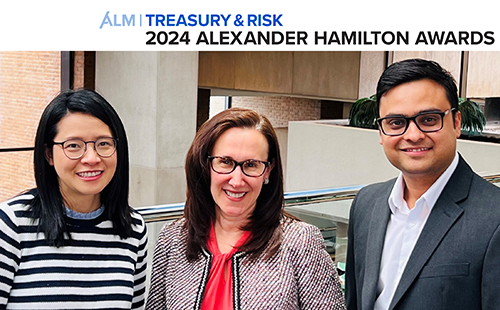
When international hospitality company NH Hotel Group developedan ambitious five-year plan for growth, it became clear that thetreasury function would need an upgrade. Based in Madrid, thecompany operates around 350 hotels located mostly in city centersthroughout 30 European and Latin American countries.
|“Our headquarters are in Spain, but we had grown throughacquisitions and ended up with a largely decentralized treasurymodel,” says Luis Martinez Jurado, senior vice president oftreasury and finance for NH Hotel Group. “When thecompany embarked on our five-year plan, we had five treasurycenters in Europe and four treasury centers in Latin America. Ourlocal teams had a lot of autonomy. And we were using more than1,500 bank accounts across a large number of banks.”
|Cash flows were opaque to corporate treasury. “Each country wasmanaging cash in its own way,” says Martinez. “They were collectingfrom their customers, paying their suppliers, their rents, theirsalaries. We tried to centralize excess cash, but the processes fordoing so were rudimentary and manual.”
|Local treasury teams handled their own liquidity forecasting andplanning, as well. Once a month, they sent high-level projectionsto headquarters, but sometimes problems with the forecasts resultedin a cash deficit in a particular group. The business unit wouldborrow from the parent company through a process that was alsohighly manual: A treasury professional in the business unit wouldsend a loan request. If a corporate treasury manager in Madridapproved the loan, the funds would be sent to the requestinggroup's bank account through a manual transfer.
| NH Hotel Group was already highlyleveraged. Treasury managers knew that in order for the company tocontinue growing, it would have to gain a more consolidated view ofboth current and future cash flows. Thus, NH Hotel Group embarkedon a treasury transformation process.
NH Hotel Group was already highlyleveraged. Treasury managers knew that in order for the company tocontinue growing, it would have to gain a more consolidated view ofboth current and future cash flows. Thus, NH Hotel Group embarkedon a treasury transformation process.
Communication was key, Martinez reports. The process lead in thetransformation initiative traveled the world, meeting with localtreasury and finance staff, as well as with local banks. “The firststep was to make sure that everyone was speaking the samelanguage,” he says. “For example, we needed to be sure thateverybody was talking about the same thing when they were talkingabout issuing a 'manual' payment. For one person, it could berouting an electronic file through certain channels. For another,it might mean filling out a paper and faxing it to the bank. Weestablished a common language so that we could build a commonground of processes and procedures.”
|From there, the project team set out to rationalize thecompany's banking relationships. “We reduced the number of banksserving our European operations to four relationship banks, two ofwhich serve as cash concentrators,” Martinez says. “Some of thosealso serve our banking needs in Latin America. We chose banks withgood, bi-directional cash pooling platforms so that funds couldflow seamlessly from the country to the parent company or viceversa.”
|NH Hotel Group was transitioning to a new SAP enterpriseresource planning (ERP) system, and the treasury group rolled out atreasury management system from Kyriba at the same time. Theyconnected the Kyriba system to SAP and to all the company's bankaccounts via SWIFTNet. Cash balance information flows automaticallyfrom the banks through Kyriba into SAP. “Now, every morning, weautomatically receive a detailed cash position for all the cashbalances at the group level,” Martinez says. “There is no bankaccount that is not reflected in that cash position—so we knowevery euro, every dollar, every Mexican peso that we have in thecompany.”
|The treasury team also set up cash pooling wherever they could.“In Latin America, we cannot have a central cash pool because oftax restrictions and monetary controls,” Martinez says. “In thosecountries, when we have excess cash, the local teams manuallytransfer funds to the group-level in-house bank. In contrast, ourcash pooling in Europe is highly automated. All our banks in Europecentralize excess cash at the country level, then these masteraccounts automatically sweep cash into a single European cashpool.”
|Meanwhile, payments flow in the opposite direction. Corporatetreasury works with accounts payable to generate a batch paymentfile in SAP. That file moves automatically into the treasurymanagement system, where managers in the originating countryprovide their approvals. Then the Kyriba system produces a SWIFTfile that is submitted to the banks, via SWIFTNet, for payment.“Everything is very simple,” Martinez says. “The authorizedsignatories can give their approvals through the app on theirmobile phones and then the payment batch is automaticallysubmitted. We have streamlined our processes in bothdirections.”
|Business unit treasurers began uploading their cash flowforecasting into the system, as well. “There was a process ofeducating our local treasurers to improve their forecasting skillsand homogenizing our forecasting processes,” Martinez says. “As aresult of this effort, we now receive—every week—an updated,consolidated cash flow forecast for the coming days and months. Weended up with much more accurate cash projections for eachcountry.”
|The treasury center in Madrid handles all the transactionaltreasury for NH Hotel Group's European operations, which accountfor approximately 90 percent of the company's revenues. “Thetreasury center is the backbone of treasury operations,” Martinezsays. “We also handle all corporate borrowing: We issue bonds. Wehave some international syndicated loans. The local teams can'traise a line of credit themselves; we have to be involved in allfinancing.”
|
See also:
- On-demand webcast: Revolutionizing Legacy Treasury Processes
- Big Changes to Capital Structure Drive CorporateCompetitiveness
- When Radical Process Changes Pay Off
- A Revamped Infrastructure for IntercompanyPayments
|
Together, these changes have helped NH Hotel Group dramaticallyimprove working capital management. “Today, we have a lot ofvisibility on our cash and our projections,” Martinez says. “Thisallows us to be much more efficient and accurate in our planning.We know when we have to pay, we know when we'll have the cash, andwe know how much we need to transfer to fund each bank account. Theimproved accuracy in our forecasting allows us to make betterdecisions around liability management. For example, at the end oflast year, we decided to exercise an early redemption of one of ourbonds, worth 40 million euros, because our new forecastingvisibility let us see that those funds were pure excess cash wedidn't actually need.
|“We have made a lot of changes, both inside and outsidetreasury,” he adds. “All these changes have allowed us to reduceour average collection period from around 36 days in 2015 to lessthan 15 days now. We have increased our EBITDA through some of thechanges to our business, and our treasury transformation initiativehas enabled us to convert that EBITDA into cash that has been keyin the deleveraging of NH.”
|“As another outcome of all these changes, corporatetreasury today is assuming a new role within the NHorganization,” explains Fernando Cebada, vice president ofcorporate treasury for NH Hotel Group. “The treasury function hasevolved from a purely transactional approach to become a realbusiness partner to the rest of the company, raising and developingfront-line value-added projects that contribute to improving thecustomer experience through state-of-the-art technologies,platforms, and methods of payment. The financial environmentnowadays is subject to constant evolution, which is creating greatopportunities, and we are ready to be there leading thetransformation.”
Complete your profile to continue reading and get FREE access to Treasury & Risk, part of your ALM digital membership.
Your access to unlimited Treasury & Risk content isn’t changing.
Once you are an ALM digital member, you’ll receive:
- Critical Treasury & Risk information including in-depth analysis of treasury and finance best practices, case studies with corporate innovators, informative newsletters, educational webcasts and videos, and resources from industry leaders.
- Exclusive discounts on ALM and Treasury & Risk events.
- Access to other award-winning ALM websites including PropertyCasualty360.com and Law.com.
*May exclude premium content
Already have an account? Sign In
© 2024 ALM Global, LLC, All Rights Reserved. Request academic re-use from www.copyright.com. All other uses, submit a request to [email protected]. For more information visit Asset & Logo Licensing.








